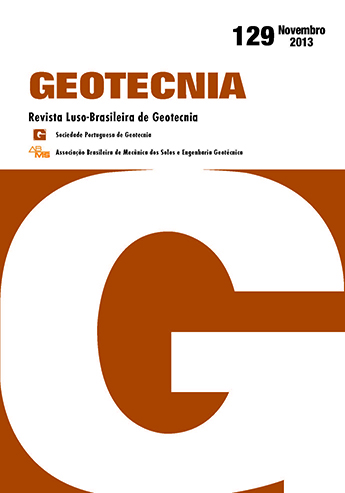Considerations on a limit equilibrium model of strain energies for rock joints
DOI:
https://doi.org/10.14195/2184-8394_129_7Keywords:
Limit equilibrium model, Dilatancy, Roughness amplitude, Peak displacement, Strain energy, DiaclasesAbstract
The limit equilibrium models of forces acting on joints within rock masses have a disadvan tage due to the impossibility of explicitly integrating the joint roughness amplitude, because they just consider non-dimensional parameters related with the asperity geometry. Actually, for an adequate joint roughness characterization it is essential to consider also its amplitude. Thus, the formulation of a limit equilibrium mo del of strain energies associated with rock joints is proposed because in the current models of limit equilibrium of forces two different joints will yield under the same shear stress when they have asperities with the same slope but different amplitudes, while in fact they actually have different strengths. In spite of some inaccuracy in factors deficiently understood of the strain energy formulations (like the amount of heat radiation, plasticity processes, and so on) the suggested formulations have encouraging relevance and likelihood, mainly while samples have a large area.
Downloads
References
Asadollahi, P.; Invernizzi, M.C.A.; Addotto, S.; Tonon, F. (2010). Experimental validation of modified Barton’s model for rock fractures. Rock Mechanics and Rock Engineering, 43, pp. 597-613.
Bandis, S. (1980). Experimental studies of scale effects on shear strength and deformation of rock joints. PhD Thesis, University of Leeds.
Barbosa, R.E. (2009). Constitutive model for small rock joint samples in the lab and large rock joint surfaces in the field. ROCKENG09, Proceedings of the 3rd CANUS Rock Mechanics Sym po - sium, Toronto.
Barton, N. (1990). Scale effects or sampling bias? Scale Effects in Rock Masses, Loen, Balkema, Rotterdam, pp. 31-55.
Barton, N.; Choubey, V. (1977). The shear strength of rock joints in theory and practice. Rock Mechanics, 10, pp. 1-54.
Beer, A.J.; Stead, D.; Coggan J. (2002). A critical assessment of discontinuity roughness characte - ri zation. Rock Mechanics and Rock Engineering, 35, pp. 65-74.
Belem, T.; Souley, M.; Homand, F. (2009). Method for quantification of wear of sheared joint walls based on surface morphology. Rock Mechanics and Rock Engineering, 42, pp. 883-910.
Brown, E.T. (1981). Rock characterization, testing & monitoring – ISRM suggested methods. Pergamon Press, Oxford.
De Blasio, F.V. (2008). Production of frictional heat and hot vapour in a model of self-lubricating landslides. Rock Mechanics and Rock Engineering, 41, pp. 219-226.
Fardin, N. (2008). Influence of structural non-stationarity of surface roughness on morphological characterization and mechanical deformation of rock joints. Rock Mechanics and Rock Engineering, 41(2), pp. 267-297.
Grasselli, G. (2001). Shear strength of rock joints on quantified surface description. PhD Thesis, École Polytechnique Fédérale de Lausanne.
Grasselli, G.; Egger, P. (2003). Constitutive law for the shear strength of rock joints based on three dimensional surface parameters. International Journal of Rock Mechanics & Mining Sciences, 40, pp. 25-40.
Karami, A.; Stead, D. (2008). Asperity degradation and damage in direct shear test: a hybrid FEM/DEM approach. Rock Mechanics and Rock Engineering, 41(2), 229-266.
Jaeger, J.C. (1971). Friction of rocks and stability of rock slopes. Géotechnique, 21, nº 2, pp. 97-134.
Jing, L.; Stephansson, O.; Nordlund, E. (1993). Study of rock joints under cyclic loading conditions. Rock Mechanics and Rock Engineering, 26(3), pp. 215-232.
Ladanyi, B.; Archambault, G. (1970). Simulation of shear behavior of a jointed rock mass. Proc. 11th Symp. on Rock Mech. (AIME), Berkeley, California, pp. 105-125.
Leal Gomes, M.J.A. (1998). O efeito de escala em maciços rochosos – o caso da resistência e deformabilidade das descontinuidades. Tese de Doutoramento, Universidade de Trás-os Montes e Alto Douro, Vila Real, Portugal.
Leal Gomes, M.J.A. (2001). The assessment of safety of rock mass joints considering their am pli - tu de of roughness. Proceedings of the ISRM Regional Symposium EUROCK 2001, Espoo, Finland, A. A. Balkema, Lisse, pp. 249-254.
Leal Gomes, M.J.A. (2010). Lucubrações sobre modelos de equilíbrio limite de resistência de des - con tinuidades em maciços rochosos. Geotecnia nº 120, Sociedade Portuguesa de Geo tec nia, LNEC, Lisboa, pp. 65-85.
Leal Gomes, M.J.A.; Dinis da Gama, C. (2007). New insights on the geomechanical concept of joint roughness. 11th ISRM Congress, Lisboa, Vol. 1, pp. 347-350.
Leal Gomes, M.J.A.; Dinis da Gama, C. (2009). An experimental study on scale effects in rock mass joint strength. Soils and Rocks, São Paulo, Vol. 32, nº3, pp. 109-122.
Marache, A.; Riss, J.; Gentier, S. (2008). Experimental and modeled mechanical behavior of a rock fracture under normal stress. Rock Mechanics and Rock Engineering, 41, pp. 869-892.
Olsson, R.; Barton, N. (2001). An improved model for hydromechanical coupling during shearing of rock joints. International Journal of Rock Mechanics and Mining Sciences, 32, pp. 317-329.
Patton, F.D. (1966). Multiple modes of shear failure in rock and related materials. PhD Thesis, University of Illinois.
Ulusay, R.; Hudson, J.A. (2007). The complete ISRM suggested methods for rock characterization, testing and monitoring: 1974-2006. Commission on Testing Methods, ISRM Turkish National Group, Ankara, Turkey.
Yoshinaka, R.; Yoshida, J.; Arai, H.; Arisaka, S. (1993). Scale effects on shear strength and deformability of rock joints. Scale Effects in Rock Masses, Lisbon, Balkema, Rotterdam, pp. 143-149.




